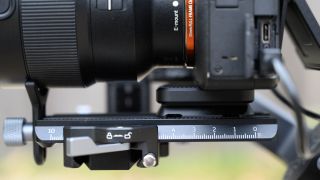The Zhiyun Weebill 2 is a 3-axis gimbal for stabilising a range of cameras up to models like the Sony A7 III and Canon 5D Mark IV with 24-70mm f/2.8 lens mounted. While it’s heavier than the Weebill-S its not as big or as heavy as the Zhiyun Crane 2S.
It has a similar upside-down L-shaped body compared to its predecessor, but the controls have been rearranged and there’s a new vari-angle touchscreen. There's a lot of competition in the DSLR and mirrorless camera gimbal market right now, and Zhiyun faces plenty of competition from DJI and FeiyuTech – and even Manfrotto has got in on the act with the Manfrotto MVG220 (actually a rebadged FeiyuTech).
Specifications
Tilt mechanical range: Max: + 190°, Min: -150°
Roll Mechanical Range: Max: +80°, Min: -260°
Pan Mechanical Range: 360º
Gimbal modes: Pan Follow, Locking, Point of View, Follow, Go, Vortex
Battery life: 9 hours
Dimensions: 35 x 22.5 x 15cm
Weight: 1.47Kg including the internal battery
Key features

The Weebill 2 has an Infineon sensor and an improved core algorithm plus upgraded motor torque to give it greater stabilising power. Zhiyun is always a bit cagey about payloads but the Weebill 2 is thought to be able to support a payload of up to around 4Kg.
For the first time on a gimbal, the Weebill 2 has a 2.88-inch vari-angle colour touchscreen. This folds in against the horizontal section of the gimbal’s body and can be flipped out for use. It can display a menu of features, but when the gimbal is paired with Zhiyun’s TransMount Video Transmission Transmitter AI, it can also be used to view the scene and to monitor the SmartFollow object tracking.
As usual, the Weebill 2 has a collection of stabiliser modes including Pan Follow, Lock, Follow, Point of View, Vortex, Go and Portrait. Pan Follow makes a good default choice but part of the skill in using a gimbal is selecting the right mode for the shooting situation.
Zhiyun supplies the Weebill 2 with a mini tripod that can be attached to the base of the grip during balancing and shooting when the gimbal is controlled remotely via the free Zhiyun smartphone app. with the legs closed in, this tripod is also useful as an extension to the handle. Alternatively, it can be attached to the end of the horizontal section of the gimbal to create a sling-style grip which is particularly useful for low-level shooting.
Build and handling


Slightly larger and around 500g heavier than its predecessor, the Weebill 2 also has a higher quality feel, a more ergonomic grip and a better control arrangement. The main grip, for example, is clear of controls and with the exception of the trigger button around the front, the controls are all on the left of the horizontal section. This makes them less likely to be pressed or nudged accidentally, but still easy to locate. However, left-handed users will not be so happy with the location of the controls.
As usual, after charging the Weebill 2’s battery, the first step in using it is to balance the camera on it. If you’ve not done this before, allow yourself 30 minutes, but it gets quicker and easier with practice. All the moving part sliding easily and smoothly so it doesn’t take long to find the correct balance point with each axis.
Performance
When it’s not in use the Weebill 2’s axis locks keep the arms neatly aligned for easier storage and transportation. There’s no annoying ‘chatter’ from the locks as you walk. The locks are also easy to use and, unlike the Weebill-S, they never seem to stick so you can unlock everything quickly.
Most importantly, the Weebill 2 does a really excellent job of stabilising the footage recorded on a camera like the Panasonic GH5 II or Sony A7 III. However, it seems quite a snug fit for a full-frame camera with a 24-70mm f/2.8 lens and you need to take care with the angle of the camera’s screen.
Naturally, it pays to hold the gimbal steady, but it generally flatters your skills and smooths out the bounce, shake and wobble that happens when you walk with a camera.
Verdict

Like any gimbal, the main purpose of the Weebill 2 is to produce more stable, better quality footage, and it does that well even in when it’s being carried over uneven ground. It also enables a wide range of creative opportunities to make the video more dynamic and interesting.
Read more:
• Best gimbals
• Best video tripods
• Best mini tripods
• Best cameras for filmmaking
• Best vlogging cameras

